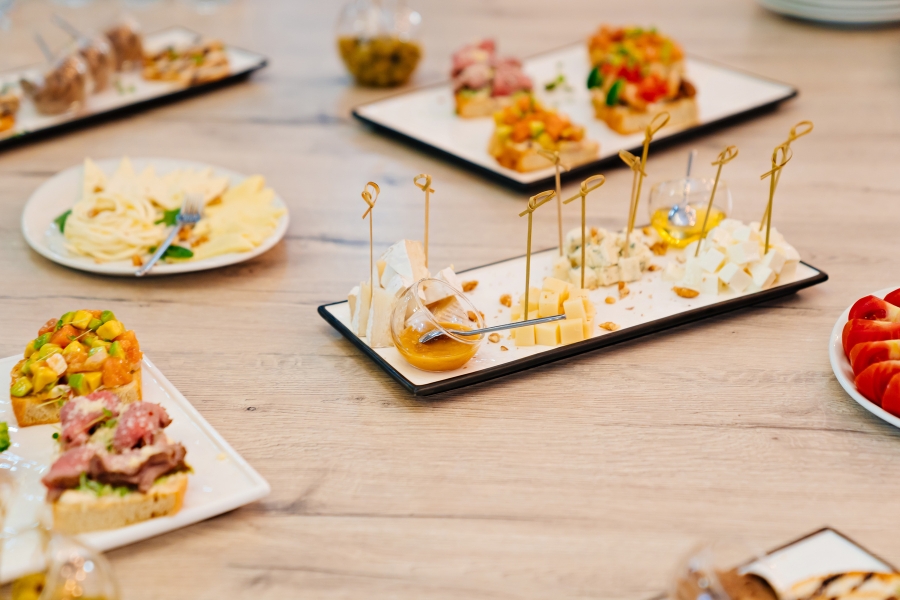
Pairing food and beverages is more than a skill; it’s an art that transforms a meal into a curated sensory experience. The perfect pairing elevates the flavors of both the dish and the drink, enhancing the overall enjoyment for diners. Whether you’re planning an intimate dinner, a corporate event, or a lavish wedding reception, mastering food and beverage pairings can leave a lasting impression. Here’s how to craft a memorable pairing experience, complete with actionable tips, creative ideas, and menu inspirations.
The Science of Pairing: A Balancing Act of Flavors
Creating the perfect pairing begins with understanding how flavors interact. It’s not just about matching similar tastes—it’s about finding balance and contrast to bring out the best in both the dish and the drink.
Balance: A rich and creamy risotto pairs well with a crisp white wine like Sauvignon Blanc, whose acidity cuts through the dish’s richness. Contrast: Spicy dishes like Thai curry benefit from sweeter drinks, such as a semi-sweet Riesling, which offsets the heat while refreshing the palate. Harmony: Matching complementary flavors can create an unforgettable harmony. A smoky barbecue rib pairs beautifully with a bourbon cocktail, as the smoky, caramel notes of the drink mirror the flavors in the dish.
Understanding the balance between sweetness, acidity, bitterness, and umami is the cornerstone of successful pairing. Once mastered, it opens a world of culinary possibilities.
Key Tips for Creating Perfect Pairings
Pairing food and beverages doesn’t have to be intimidating. With a few guiding principles, you can create combinations that delight your guests and ensure a memorable event.
Match Flavor Intensity: Ensure the drink doesn’t overpower the dish and vice versa. A delicate fish dish pairs best with a light wine, while bold, meaty flavors call for fuller-bodied options like a Malbec or Syrah. Highlight Regional Synergy: Pair dishes and drinks from the same region. For example, Italian dishes like pasta with a rich tomato sauce shine when paired with a Chianti. Consider the Occasion: Tailor pairings to the style and tone of the event. A formal dinner may call for classic wine pairings, while a casual gathering might embrace creative cocktail pairings. Accommodate Variety: Offer versatile options like sparkling wine, which pairs well with a range of foods, or creative mocktails for non-drinkers.
These tips ensure a thoughtful approach to pairing, guaranteeing that every guest finds something to enjoy.
Crafting Unique Pairing Experiences
Creating a memorable pairing experience is as much about storytelling and creativity as it is about the food and drink. Elevate your event with unique and interactive elements that engage your guests.
Thematic Pairings: Design your menu around a cohesive theme. For a Mediterranean-inspired event, pair Greek mezze platters with a crisp Assyrtiko wine and finish with baklava complemented by a honey-infused dessert wine. Interactive Pairing Stations: Incorporate a hands-on element by setting up tasting stations. Guests can experiment with different combinations, such as pairing cheeses with wines or assembling small plates to match curated cocktails. These stations turn dining into an engaging activity, making the experience more dynamic. Cultural Journeys: Take your guests on a culinary adventure by featuring regional pairings. For a French-inspired evening, serve duck confit with Bordeaux, followed by a rich chocolate mousse accompanied by a sparkling rosé. Highlighting the origin and story of each pairing adds depth and intrigue. Educational Moments: Offer guests insights into why certain pairings work. Brief tasting notes or a knowledgeable host explaining the science behind the flavors can add a layer of sophistication and engagement to the experience.
Sample Menus to Inspire Your Pairings
Crafting a menu that flows seamlessly from start to finish is crucial to a successful pairing experience. Here are sample menus with thoughtfully chosen pairings to guide your planning:
Appetizers Seared scallops with lemon butter sauce paired with Sauvignon Blanc with bright citrus notes to enhance the dish’s freshness. A cucumber mint mocktail for a refreshing, alcohol-free option. Smoked salmon canapés with dill cream cheese paired with dry sparkling wine like Prosecco to complement the rich, smoky flavor.
Main Courses Herb-crusted rack of lamb with rosemary jus complemented by Syrah, with its bold, peppery notes that accentuate the lamb’s seasoning. A rosemary and blackberry spritzer for non-alcoholic diners. Wild mushroom risotto with Parmesan paired with earthy Pinot Noir that mirrors the umami of the mushrooms.
Desserts Dark chocolate lava cake with a hint of chili matched with Port or a bold Zinfandel to balance the richness with a touch of sweetness. Spiced chai latte for a warming, flavorful non-alcoholic finish. Lemon tart with meringue paired with Limoncello or a bright Moscato d’Asti.
The Role of Presentation in Pairing Experiences
Presentation transforms a great pairing into an unforgettable one. Food and drink should be visually appealing, reflecting the effort and thought behind the combination. Use elegant glassware, fresh garnishes, and creative plating to elevate the aesthetic. A glass of sparkling wine with a twist of lemon peel or a cocktail served with edible flowers can make a lasting impression.
Pairing cards or menu descriptions can also enhance the experience. Briefly describe the flavor notes and the reason for each pairing to create a connection between the dish, the drink, and the guest.
Seasonality and Sustainability: Flavor with a Conscience
Incorporating seasonal ingredients not only enhances flavor but also demonstrates a commitment to sustainability. A spring menu featuring fresh asparagus paired with a bright white wine celebrates the season’s bounty. In fall, roasted squash dishes with a bold red wine highlight the warmth of the harvest. Seasonal pairings align with nature’s rhythms, creating an authentic dining experience.
Supporting local producers and using in-season ingredients also reduces the environmental impact of your event, making your pairing experience as responsible as it is delicious.
Conclusion: Crafting a Symphony of Flavors
A memorable food and beverage pairing experience goes beyond the plate and glass—it’s about creating an event that resonates with guests long after the final course. By understanding the principles of pairing, embracing creativity, and adding thoughtful touches, you can elevate any meal into a harmonious journey of flavors. Whether you’re hosting a refined wine pairing dinner or a playful cocktail tasting party, the right combinations can transform your event into an unforgettable celebration of taste.
